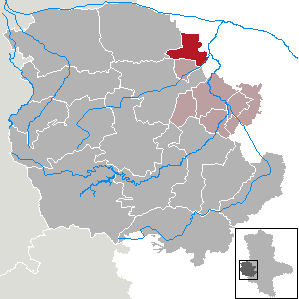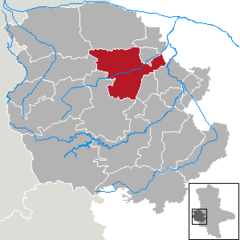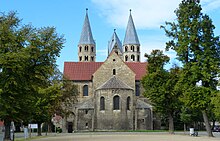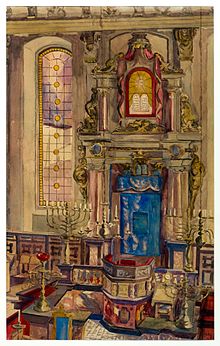
Quedlinburg is a town situated just north of the Harz mountains, in the district of Harz in the west of Saxony-Anhalt, Germany. As an influential and prosperous trading centre during the early Middle Ages, Quedlinburg became a center of influence under the Ottonian dynasty in the 10th and 11th centuries. The castle, church and old town, dating from this time of influence, were added to the UNESCO World Heritage List in 1994 because of their exceptional preservation and outstanding Romanesque architecture.

Saxony-Anhalt is a state of Germany, bordering the states of Brandenburg, Saxony, Thuringia and Lower Saxony. It covers an area of 20,451.7 square kilometres (7,896.4 sq mi) and has a population of 2.17 million inhabitants, making it the 8th-largest state in Germany by area and the 11th-largest by population. Its capital is Magdeburg and its largest city is Halle (Saale).

Halberstadt was a district (Kreis) in the middle of Saxony-Anhalt, Germany. Neighboring districts were Bördekreis, Quedlinburg, Wernigerode, Goslar, Wolfenbüttel, Helmstedt.

The Province of Saxony, also known as Prussian Saxony, was a province of the Kingdom of Prussia and later the Free State of Prussia from 1816 until 1944. Its capital was Magdeburg.

Eastphalia is a historical region in northern Germany, encompassing the eastern Gaue (shires) of the historic stem duchy of Saxony, roughly confined by the River Leine in the west and the Elbe and Saale in the east. The territory corresponds with modern southeastern Lower Saxony, western Saxony-Anhalt, and northern Thuringia. Together with Westphalia, central Angria, and Nordalbingia, it was one of the four main Saxon administrative regions.

The Diocese of Halberstadt was a Roman Catholic diocese from 804 until 1648. From 1180, the bishops or administrators of Halberstadt ruled a state within the Holy Roman Empire, the prince-bishopric of Halberstadt. The diocesan seat and secular capital was Halberstadt in present-day Saxony-Anhalt.

Blankenburg (Harz) is a town and health resort in the district of Harz in Saxony-Anhalt, Germany, at the north foot of the Harz Mountains, 12 miles (19 km) southwest of Halberstadt.

Falkenstein/Harz is a town in the Harz district, in Saxony-Anhalt, Germany. It was created in 2002 by merging the town of Ermsleben with the former municipalities of Endorf, Meisdorf, Neuplatendorf, Pansfelde, Reinstedt und Wieserode. The new community was named after Falkenstein Castle.

Egeln is a small town in the Salzlandkreis district, in Saxony-Anhalt, Germany. It is the administrative seat of the Verbandsgemeinde Egelner Mulde.

Schwanebeck is a small town in the district of Harz, in Saxony-Anhalt, Germany. It is part of the Verbandsgemeinde Vorharz.

Wegeleben is a town in the Harz district, in Saxony-Anhalt, Germany. It is the administrative seat of the Verbandsgemeinde Vorharz.

Osterwieck is a historic town in the Harz district, in the German state of Saxony-Anhalt.

Oberharz am Brocken is a town in the Harz District, in Saxony-Anhalt, Germany. It was formed on 1 January 2010 by the merger of the town of Elbingerode with the municipalities of the former Verwaltungsgemeinschaft Brocken-Hochharz.

The Magdeburg–Thale railway is a predominantly single-track, non-electrified main line railway that connects Thale, in the northern Harz, with Magdeburg, the capital of Saxony-Anhalt. Its eastern section between Magdeburg and Halberstadt was opened in 1843 and it is one of the oldest railways in Germany.

Transdev Sachsen-Anhalt is a regional railway company, a subsidiary of Transdev Germany. It provided passenger services on the North Harz network from 2005 to 2018 under the name HEX (HarzElbeExpress).
Halberstadt is a town in the German state of Saxony-Anhalt and the capital of the district of Harz.

The Halberstadt tramway network is a network of tramways forming part of the public transport system in Halberstadt, a city in the federal state of Saxony-Anhalt, Germany.

Halberstadt station is a station on the Magdeburg–Thale railway in Halberstadt in the German state of Saxony-Anhalt. A terminal station was opened in the town in 1843. A new through station was opened in another part of the town in 1868. The first service from Halberstadt ran to Magdeburg. Two more lines were added during the next few decades. In the Second World War, the station suffered heavy damage. Extensive modernisation work took place between 2008 and 2010. The entrance building and the locomotive depot are listed buildings.

The Halberstadt–Blankenburg railway is a non-electrified, single-track railway line, from Halberstadt via Langenstein and Börnecke to Blankenburg in the German state of Saxony-Anhalt. The Rübeland Railway connects to the line at Blankenburg (Harz) station. Until 1968, there was a branch to Derenburg. The branch line originally ran to Minsleben.

Klamer Eberhard Karl Schmidt was a jurist and a popular German poet-lyricist.


































